

Burnout: 9 Signs You’re Reaching Exhaustion. Burnout is more than just a feeling: In fact, the World Health Organization (W.H.O.) recognizes it as an official syndrome stemming from chronic workplace stress.
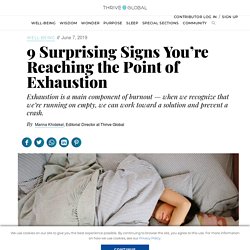
Our always-on culture simply isn’t working: Research has shown that experiencing signs of burnout is becoming a constant across industries. Burnout is characterized by three key factors: “feelings of energy depletion or exhaustion; increased mental distance from one’s job, or feelings of negativism or cynicism related to one’s job; and reduced professional efficacy,” according to W.H.O.
Let’s zero in on one of those factors: exhaustion. If you’ve ever experienced it, you know how stressful and taxing it feels to be constantly running on empty. That’s why it’s so crucial to be able to recognize when we’re nearing that point, so we can work toward a solution and prevent hitting a point of no return. Yoga for Osteoporosis: A Pilot Study : Topics in Geriatric Rehabilitation.
OSTEOPOROSIS and osteopenia are better understood than they were even a decade ago, yet ancient methods appear applicable to their prevention and cure.
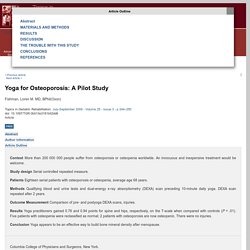
We conducted a pilot study using yoga to reduce and ultimately prevent osteopenia and osteoporosis. Many of the world's estimated 200 000 000 sufferers of osteoporosis and osteopenia are unlikely ever to be able to afford either medication for these conditions or treatment of the fractures that are their consequence.1 Those receiving bisphosphonates, by far the most common pharmacological treatment, are at increased risk for gastrointestinal disorders, osteonecrosis, and severe muscle cramps,2,3 and while medicines such as loop diuretics strongly promote osteoporosis through calcium loss, calcium itself promotes cardiovascular and cerebrovascular events and sudden death in people older than 75 years.4 Everett Smith outlined the support for “unusual pulls” bones as a means of building bone strength.
We will certainly continue our study. Videos. Development of Insight: The Insight Knowledges. Achieving Mindfulness at Work, No Meditation Cushion Required. Photo In a recent seminar I gave for over 100 business professionals, I asked the participants to play a simple word association game with me: “I say mindfulness, you say ________.”

The word that rang out in unison was, of course, “meditation.” Mindfulness, it seems, has become a mainstream business practice and a kind of industry in its own right. Meditation instructors are the new management gurus, and companies including Google, General Electric, Ford Motor and American Express are sending their employees to classes that can run up to $50,000 for a large audience. Many mindfulness apps exist, nearly all of which focus on “mindfulness meditation.” Get Ready for the Starbucks of Yoga. Editor's note: This article is part of Inc.'s 2015 Best Industries report.
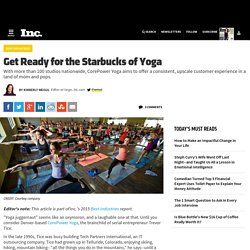
"Yoga juggernaut" seems like an oxymoron, and a laughable one at that. Until you consider Denver-based CorePower Yoga, the brainchild of serial entrepreneur Trevor Tice. In the late 1990s, Tice was busy building Tech Partners International, an IT outsourcing company. Tice had grown up in Telluride, Colorado, enjoying skiing, hiking, mountain biking--"all the things you do in the mountains," he says--until a rock-climbing accident shattered both his ankles. Knowing he'd never be able to rock climb or mountain bike in the same way again, Tice turned to yoga. Steve Jobs's Secret to Greatness: Yogananda and Self-Realization. Fastcompany. If you are like me, you probably find yourself multitasking more, yet feeling like it really isn’t benefiting you.
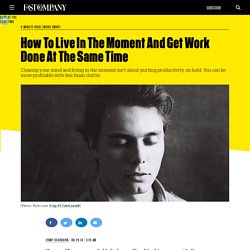
As a society, we’re stressing out about more and accomplishing less, adversely impacting both our mindsets and our productivity. Most of us think of this as the new normal, and we’ve gotten used to juggling more. The begrudging acceptance of this attitude prevents companies from taking actions needed to keep workers focused and productive. A stretched-thin, stressed-out workplace is not the workplace of the future. It falls on business managers to change this culture and promote focus and compassion—a concept making the rounds in workplace circles known as "mindfulness. " Studies have found that mindfulness at work can increase engagement, productivity, innovation, and measurable business results. 1. Neuroscience research shows that even short trainings in mindfulness can measurably reduce stress and increase cooperation and team-building. 2.
The Practice. Welcome to Mindfulness Foundation - Mindfulness in Schools Campaign - Focus : Daniel Goleman. Focus: The Hidden Driver of Excellence, by Daniel Goleman, HarperCollins/Bloomsbury, £18.99 Please concentrate.
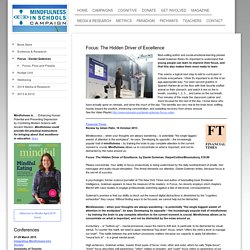
Your ability to focus productively is being undermined by the daily bombardment of emails, text messages and audio-visual stimulation. This threat demands our attention, Daniel Goleman writes, because focus is the secret of success. A psychologist, former science journalist at The New York Times and author of bestselling book Emotional Intelligence, Goleman appears to have the measure of his readers. In Focus, he cleverly employs short chapters littered with case studies to engage professionals swimming against a tide of electronic correspondence. Goleman's premise is that our ability to block out the massof digital distractions is diminished by the "cognitive exhaustion" they cause. Mindlessness – when your thoughts are always wandering – is potentially "the single biggest waster of attention in the workplace", he says.
Copyright The Financial Times Limited 2013. Search Inside Yourself Leadership Institute.